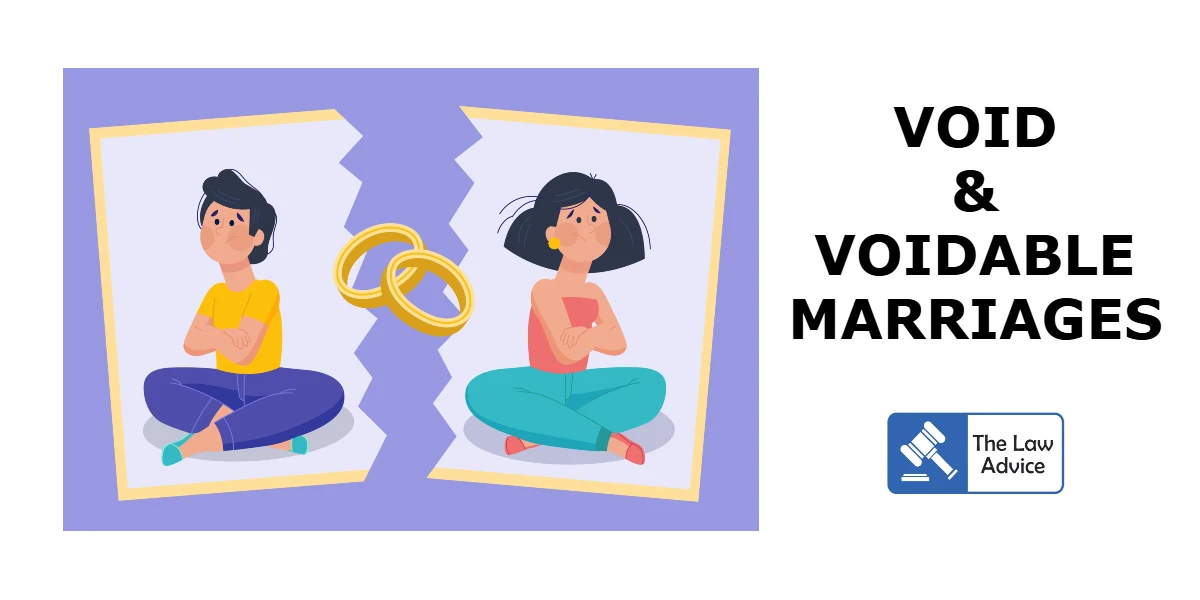Void and Voidable Marriages
Marriage holds a profound place in Indian society, rooted in centuries of cultural, religious, and societal values. As a cornerstone of personal law, marriage is not merely a social contract but a legal and spiritual commitment. The complexity of India’s diverse population is reflected in its legal framework, where multiple personal laws govern matrimonial issues based on religious affiliations. Central to this legal discourse are the concepts of void and voidable marriages—key classifications that define the validity and enforceability of a marital union. Understanding these distinctions is essential for interpreting rights, obligations, and remedies within marital relationships.
While a void marriage is deemed non-existent from the outset, a voidable marriage is legally valid unless annulled by a court decree. These distinctions have significant ramifications, including inheritance rights, maintenance claims, and the legitimacy of offspring. For Hindus, these principles are primarily governed by the Hindu Marriage Act, 1955, which sets out the conditions under which a marriage may be void or voidable.
Void Marriages
A void marriage is one that is legally invalid from the beginning. It holds no legal standing and is treated as if it never occurred. Section 11 of the Hindu Marriage Act outlines circumstances that render a marriage void:
-
Bigamy: Marrying while a prior spouse is still alive.
-
Prohibited Degrees: Marriages within certain close relations, unless permitted by custom.
-
Sapinda Relationship: Marriage between close blood relatives, again unless allowed by custom.
In such unions, the couple does not enjoy spousal status, and mutual matrimonial rights do not exist. However, under Section 16, children born from such marriages are considered legitimate.
Voidable Marriages
A voidable marriage is valid unless and until annulled by court decree under Section 12 of the Hindu Marriage Act. Grounds include:
-
Consent obtained by fraud or force
-
Mental incapacity to consent or sustain marriage
-
Impotency of the respondent at the time of marriage
-
Wife pregnant by another man, unknown to the husband at the time of marriage
Unlike void marriages, these unions require formal annulment, and until such decree is passed, spouses retain legal status and rights.
Historical Development
Ancient and Medieval Periods
Marriage was governed by religious doctrines. For Hindus, it was a sacred duty, not a contract. The idea of annulment or legal invalidity was alien to traditional practice.
Colonial Period
British influence brought legal recognition to marriage. Laws such as the Indian Christian Marriage Act (1872) and Hindu Marriage Act (1891) introduced statutory frameworks. During this time, clearer distinctions between void and voidable marriages began to emerge.
Post-Independence Reforms
The Hindu Marriage Act, 1955, introduced landmark provisions for annulment, divorce, and judicial separation:
-
Set legal age for marriage (21 for men, 18 for women)
-
Enforced monogamy
-
Defined Sections 11 and 12 for void and voidable marriages
The Special Marriage Act, 1954 added a secular dimension, allowing interfaith and civil marriages.
Contemporary Challenges and Evolving Jurisprudence
Recent developments have reshaped marriage laws to reflect societal changes:
-
Live-in relationships have gained some legal recognition.
-
Same-sex marriage debates are influencing legal interpretations.
-
The Prohibition of Child Marriage Act, 2006, reinforced legal age requirements and enabled annulment of child marriages.
These changes mark a shift toward individual autonomy and equality, moving away from rigid customs.
Legal Provisions, Procedures, and Implications
Void Marriages
Section 11, Hindu Marriage Act
Conditions:
-
Bigamy
-
Prohibited degrees
-
Sapinda relationship
Implications:
-
Automatically null
-
No spousal rights
-
No maintenance (generally)
-
Children deemed legitimate under Section 16
Procedure:
-
No decree needed, but parties may seek declaratory decree
Voidable Marriages
Section 12, Hindu Marriage Act
Grounds:
-
Consent by fraud or coercion
-
Unsound mind
-
Impotency
-
Pregnancy by another man
Implications:
-
Valid unless annulled
-
Parties retain spousal rights until decree
Procedure:
-
Petition in family/district court
-
Must be filed within one year (or one year from discovery of fraud)
-
Requires evidence: documents, witness testimony, medical reports
-
Interim orders possible
-
Appeals may lie to High Courts and Supreme Court
Special Considerations
-
Legitimacy of Children: Guaranteed under Section 16.
-
Maintenance: Limited rights in void marriages; possible under Section 125 CrPC in specific cases.
-
Property Division: May be ordered by courts post-annulment.
-
Religious Variance: Personal laws differ; Uniform Civil Code debate continues.
Key Case Laws
-
Yamunabai Anantrao Adhav v. Anantrao Shivram Adhav (1988): Bigamy renders second marriage void.
-
Lily Thomas v. Union of India (2000): Conversion to Islam to remarry invalidates the second marriage.
-
Reena Agrawal v. Anupam (2004): Fraud as a valid ground for annulment.
-
Praveen Mehta v. Inderjit Mehta (2002): Clarified mental illness criteria.
-
Pinninti Venkataramana v. State (1977): Customary exceptions to prohibited degrees require strict proof.
Appreciation and Criticism
Positives
-
Ensures individual rights and consent in marriage
-
Protects children’s legal status
-
Judiciary has adapted to evolving social norms
Criticisms
-
Gender bias in voidable grounds (e.g., premarital pregnancy)
-
Inconsistent provisions across personal laws
-
Obsolete grounds like impotency
-
Exclusion of LGBTQ+ rights
-
No clear maintenance for spouses in void marriages
Conclusion and Recommendations
Key Findings
-
Clear legal distinction provides structure and legal clarity.
-
Indian framework is evolving but still mirrors traditional norms.
-
Judicial activism has bridged many statutory gaps.
-
There’s a need for uniformity and modernization.
Suggestions
-
Simplify annulment procedures to reduce delays.
-
Uniform Civil Code to harmonize grounds across religions.
-
Update voidable marriage grounds to reflect contemporary realities.
-
Include same-sex marriages in legal frameworks.
-
Provide maintenance safeguards for spouses unaware of a void marriage.
-
Modernize mental health considerations in annulment grounds.
Final Thoughts
The evolving interpretation of void and voidable marriages reveals the judiciary’s attempt to balance ancient traditions with modern legal standards. Moving forward, legal reforms must ensure equality, inclusiveness, and respect for personal autonomy. Strengthening these frameworks will reflect India's commitment to progressive values while honoring its diverse cultural roots.

